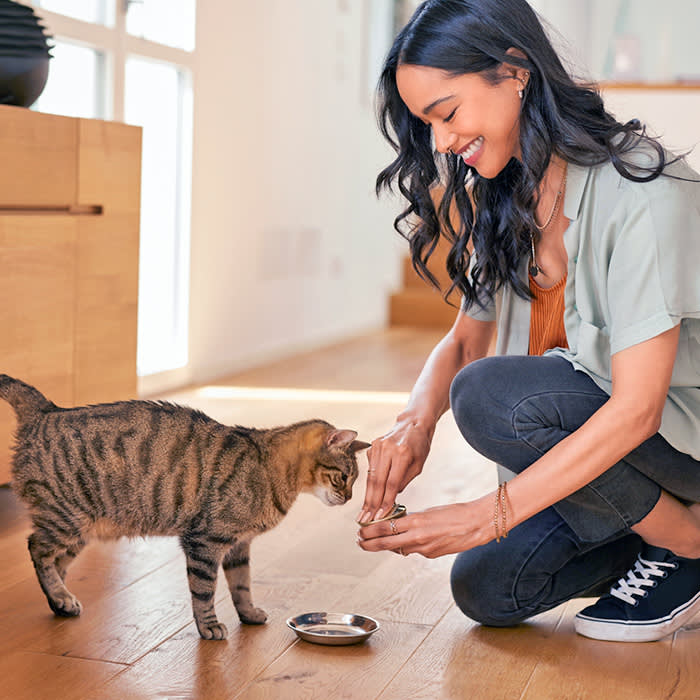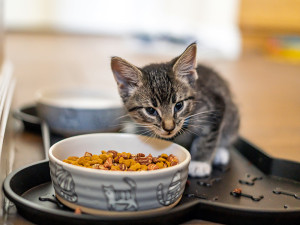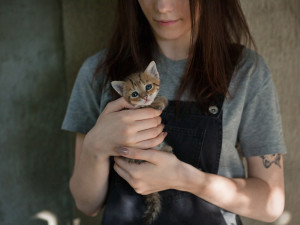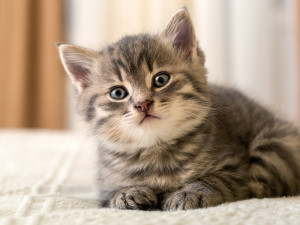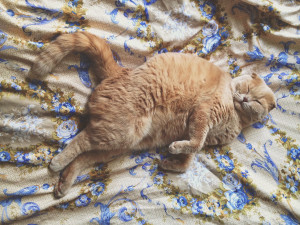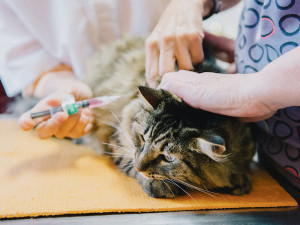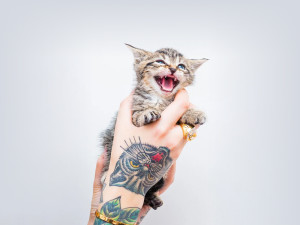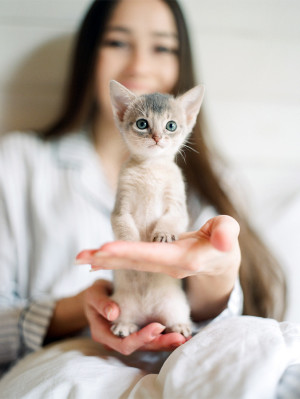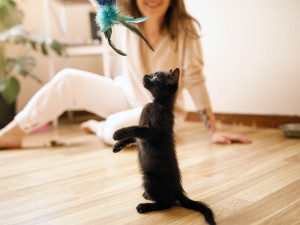When Can a Kitten Eat Wet Food?
And how to know what kind they need.
In This Article:
When Can Kittens Start Eating Wet Food? Benefits of Wet Food for Kittens Best Wet Cat Food for Kittens How Do You Introduce Wet Food to Kittens
Wet food is a key part of a kitten’s diet, providing essential moisture, nutrients, interesting flavors, and textures that support healthy development. While kittens can start eating wet food as early as three to four weeks old, it’s crucial to choose an age-appropriate formula and introduce it gradually.
When can a kitten eat wet food?
Solid foods are usually introduced to kittens around four weeks old. At this stage, they are just starting to have adorable, razor-sharp kitten teeth. They’ll need their solid food to be mushed up into a gruel-like consistency while they learn to eat from a bowl and chew their food. There are some important considerations to keep in mind when introducing wet food to kittens.
When can kittens start eating wet food?
Most kittens are ready to start eating very mushy wet food at around four weeks old. At that age, they continue to nurse and get important nurturing and socialization from their mothers and siblings. Here are some of the gradual steps kittens take towards eating solid foods:
Weaning from mother’s milk
Weaning is the gradual process of transitioning from nursing to eating solid foods. Ideally, this is a slow process that takes place over many weeks. Newborn kittens nurse exclusively and obtain all of their necessary nutrients through their mother’s milk. They also receive critical immune factors that protect them from disease while their own immune systems are immature. In a perfect situation, kittens start to eat small amounts of mushy solids around four weeks old and start to nurse less frequently over the next few weeks.
How much do you spend on your pet per year?
By six to eight weeks old, kittens wean completely and are eating only solid foods. Often, things happen very differently in reality, whether kittens are left orphaned without a mother cat and need to be bottle-fed, or they need to be separated earlier for various reasons. In those cases, kittens still need to have kitten-specific formula as their main source of nutrition until they can eat solid foods.
Sudden and early separations of mothers and kittens are not ideal; they can be very stressful and lead to physical and behavioral challenges so it is best to allow gradual weaning whenever possible.
Age range
You can introduce very mushy wet food to kittens around three to four weeks old. Keep in mind that kittens at this age have never eaten from a bowl or had to chew before, so they usually start by trying to suckle on the food as if they are nursing, and eventually learn to lap it up. They should have a very shallow dish of mushy canned food that is mixed with either water or kitten formula.
Some kittens may show no interest in canned food at first and prefer to nurse, but over the next few weeks, they will become more comfortable eating from a dish and start to add more solid food to their diet. Typically, they will nurse less and less during this time until they are exclusively eating solid food. For kittens that were bottle-feeding, they should also be encouraged to start eating solids around this age and bottle-feed less frequently as long as they are eating well. It is important to monitor their weight during this transition to ensure they continue gaining weight and are eating enough overall.
Developmental milestones and readiness signs
One of the big changes that helps determine their readiness to eat solid food is the eruption of their kitten teeth, which usually come in between three to four weeks old. They should have a full set of kitten teeth by six weeks old. Adult teeth erupt around 11 weeks old, and most cats have all of their adult teeth by six months old. Young kittens also gain about one pound per month until about 10 weeks old, and then their growth can be more variable.
This is a good way to track their growth as they should be consistently gaining weight at this pace during those early weeks and through weaning. The rapid growth phase typically ends by about one year old, although some large breeds may continue growing until closer to 18 months. During the first year of life, kittens are very active and growing rapidly, so they need to have a higher calorie intake and eat more frequently.
Once they reach about one year old, they no longer have the same energy demands and it is important to modify their diet to reflect that by transitioning to adult cat food. To avoid unintentionally overfeeding your cat, adult cats should have consistent meal times and be fed a measured portion of food based on their size, age, and the guidelines on the food label.
Benefits of wet food for kittens
Take advantage of the curiosity of your kitten to introduce a wide variety of flavors and textures in their diet. This may help prevent pickiness later on. It’s a good idea to introduce all different kinds of food at this stage. There are some particular advantages to wet food that are worth noting
High-moisture content
Wet food contains a lot of moisture compared to dry food. This is especially beneficial to cats because they don’t usually drink much water. As they age, they may need to increase their water intake for a variety of health reasons such as urinary issues, kidney disease, and/or as part of a weight-loss plan. If they already like wet food, it will be easier to transition them to eating only wet food, if necessary.
Palatability and texture variety
There are endless combinations of flavors and textures when it comes to wet food; there are patés, chunks in gravy, shredded stews, and more. Many cats like the variety, and it can be fun to switch up their meals so they don’t eat the exact same food for every meal day in and day out.
This also helps prevent picky eating as they get older. The more they are accustomed to different flavors and textures when they are young, the more likely they will accept diet changes as they get older. This can be helpful if they need a special diet due to medical problems later on.
Nutrient-dense formulas
All commercial cat foods that are labeled for kittens, and/or for growth and reproductive stages, are required to be balanced with all of the nutrients that a growing kitten needs. This means it is a high-calorie, nutrient-dense formulation so that they don’t have to eat as large of a portion of food to get all of their nutrients. This is especially important in young kittens since their stomachs are small and they can’t eat a large volume of food in each sitting.
By creating nutrient-dense formulations, they can still meet their needs in a smaller volume of food. This also means that these foods would provide way too many calories for adult cats who can eat a larger portion at each meal and who have lower metabolic demands. Be sure to make the transition to a food formulated for adult cats once they reach their full size, usually around one year old. This will help prevent unintentional weight gain.
Best wet cat food for kittens
Age-specific formulas
It is very important that kittens eat a food that is specifically formulated for their age. Most foods will be labeled specifically as kitten food, or for growth and reproductive stages, while some may also say they are appropriate for all life stages. You will want to avoid feeding your kitten food that is meant for adult cats or senior cats because it will not be high enough in calories and other nutrients to meet their needs.
Quality ingredients and balanced nutrients
Whenever possible, feed your kitten the highest-quality diet you can. All commercial cat foods that are labeled as complete and balanced for daily nutrition are required to contain all of the nutrients cats need. Treats and meal supplements are not balanced, however, so these should not be used to replace their primary diet.
It can be tricky to analyze cat foods and determine what makes a food high quality. Cats are obligate carnivores and their needs are different from ours. While we may turn our nose up at certain ingredients like organ meats and meat by-products, these may provide important nutrients for cats that more closely resemble eating prey. Don’t be misled by marketing schemes that highlight exotic fruits or vegetables in the ingredients as these are unnecessary and unlikely to be contributing much to the actual nutrient profile of the food.
Can size
Cat food often comes in three-ounce and five-ounce cans. If you have one small kitten, you may be better off purchasing smaller cans, because your cat will not eat much at each meal. Once canned food is opened, it needs to be refrigerated to keep it from spoiling, so smaller cans may be a better strategy for reducing waste and keeping food fresh. At the same time, if you have multiple kittens, larger cans may be more convenient and cost-effective.
How do you introduce wet food to kittens?
Gradual introduction process
Remember that a young kitten has never had solid food before. It smells and tastes very different from milk and is a whole new sensation in their mouth. It is a learning process, and there will be many full-body dips in the food and mush facials as they figure it all out. This is why it is ideal to introduce solid food gradually during the weaning process.
At first, start with just a tablespoon or two of canned food mixed with water or kitten formula to create a mush with a liquid consistency. Place it in a very shallow dish that the little kittens can easily access without falling into it. The first few attempts may feel like major fails, but each exposure will help them get used to eating solids. They should have solid foods offered consistently throughout the day to give them plenty of chances to try it.
Monitoring acceptance and adjusting ratios
The weaning process can be stressful and different kittens have varying reactions to the introduction of solid foods. It‘s important during this time to carefully monitor the kittens for signs that they are not eating enough.
This can include generally noting their interest in the food as well as how much they are nursing or bottle feeding, monitoring their weights, and looking for signs of adverse reactions like vomiting or diarrhea. If they are eating solid food enthusiastically, be sure to offer plenty of food and to make sure each kitten has enough access to the food. You may need to separate kittens during feeding time if there are multiple kittens.
Age and weight guidelines
Using the general guideline that kittens gain one pound per month in the early weeks is helpful for monitoring their growth during the weaning process. A one-month old kitten should weigh about one pound, whereas a 10-week old kitten should weigh around two and a half pounds.
If you are noticing that your kitten is not consistently gaining weight, or that their weight gain slows down as they transition to solid food, you will want to reassess things and also consult a veterinarian. Some kittens may need to eat more often, or continue nursing or bottle-feeding frequently, despite starting solids, to keep up their growth.
Breed-specific considerations
The larger breeds of cats like Maine coons, Siberians, and Savannah cats are more likely to keep growing beyond the average Domestic Shorthair. For these larger cats, it is recommended to offer a kitten food diet until they are closer to 18 months old. Also, some breeds of cats, like Persians and Exotic shorthairs tend to have more trouble chewing due to their smushed faces and misaligned teeth. They may do better on a wet food diet as a result.
Portion control
For young, growing kittens, portion control is not a concern. You can use the guidelines on the can to help you figure out how much to dole out, but if your kitten is eating more than that, you can offer additional servings as needed.
Most young kittens need to eat every few hours, so if you know you will be out of the house for part of the day, you can leave dry food available to your kitten, too. Because it won’t spoil at room temperature, this can be a good way to ensure they eat enough and never go too long without a meal. As your kitten reaches their adult size, it becomes more important to implement portion control.
By 12 months old, most cats are fully grown and their metabolic needs change. At this point, you should switch your cat to an adult formulation of cat food and be more strict about following portion sizes so you don’t unintentionally overfeed your cat. Adult indoor cats tend to be more inactive, so they are at risk for weight gain if they also eat an abundance of calories.
Free-feeding, or leaving food out all the time, is not recommended for adult cats as they will not self-regulate but will graze all day. It is also a good idea to work on providing consistent opportunities for exercise including daily play sessions, food puzzles, and interactive toys.
FAQs (People also ask):
Do cats need high-calorie food?
Kittens and pregnant/nursing cats need higher-calorie foods than adult and senior cats. This is because they have higher metabolic needs.
Can kittens eat wet food?
Yes, kittens can eat wet food and it is a healthy choice for them. Introducing lots of variety in flavor and texture is a great way to help your kitten expand their palate and may prevent picky eating later on.
What is the best cat food for kittens?
The best foods will be complete and balanced diets that are specifically labeled for kittens or for growth and reproductive stages to ensure they provide enough calories and all of the nutrients growing kittens need.
